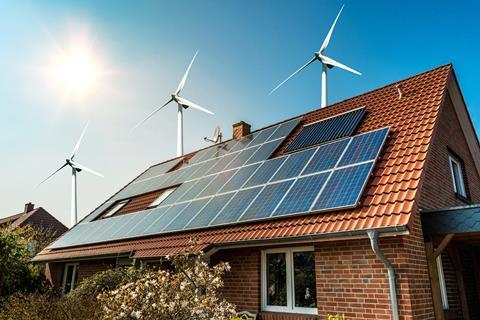With carbon emissions from homes going up and little incentive for existing homeowners to make energy efficiency renovations, we talk to policymakers and industry about a proposed solution
The problem
Record energy costs are impacting households, individuals and the wider economy. The world is warming and all UK industries must reach net zero by 2050 to meet government targets. The housing sector is no exception but, while strides are being taken in the energy efficiency of new homes, our existing housing stock poses a major problem.

The majority of homes in England are owner-occupied (65%) and, over the past decade, there has been little in the way of effective government policy or industry-led incentive to get homeowners to undertake the often expensive and disruptive changes needed to make homes greener.

We have the oldest housing stock in Europe, with a fifth of homes dating from Edwardian times or older, but the UK cannot reach net zero without making drastic and potentially expensive changes to existing homes.
The governmentтАЩs Green Homes Grant scheme - which offered vouchers to help homeowners pay for energy efficiency work - ended in April 2021 having. The Public Accounts Committee described it as тАЬa scheme with poor design and troubled implementation,тАЭ after only 47,500 homes out of an intended 600,000 were upgraded.
In 2023, heating and electricity for 29m homes accounts for 20% of our carbon emissions, using up 35% of our energy. While we all want cheaper household bills, there are currently few incentives for homeowners to spend the money needed to make homes energy secure.
Under government proposals, all homes in England and Wales will need to meet the governmentтАЩs target of an Energy Performance Certificate (EPC) C rating by 2035 тАУ that is 15m homes in need of energy efficiency work to meet this standard.
While most of us would choose to live in well-insulated homes with solar panels or heat source pumps, many households simply do not have the cash to make expensive renovations to meet higher EPC standards.
The solution?
One potential solution is being proposed by the UKGBC and the Energy Efficiency Infrastructure Group (EEIG). They have jointly devised a comprehensive system for retrofitting UK homes via an energy saving stamp duty initiative.
It is an idea that has been backed by the Good Homes Alliance, Nationwide, NatWest Group, ilke Homes, the Federation of Master Builders and many others.
In a nutshell, it incentivises homeowners to spend money on retrofitting their homes for energy efficiency at the point that they are organising financing (mortgages). The idea is that buyers would take out a mortgage as part of their purchase, and earmark some of the money for green renovations with a view to getting a tax refund later.
Under the scheme, a buyer would pay more or less stamp duty depending on the efficiency of the home they are purchasing. If the homeowner goes on to make energy efficiency changes within two years, they can get a rebate on some of the tax paid.
The rebate system would follow the model in place for owners of second homes, who can get a rebate of stamp duty surcharge if they sell their additional property within two years.
тАЬWeтАЩre suggesting nudging stamp duty up and down based on a point which is calculated to be revenue-neutral to the Treasury, which obviously takes into account the rebates that will be paid in the two-year period as well,тАЭ says David Adams, a spokesperson for the EEIG.
тАЬBuyers have the choice of not improving their homes, improving modestly or significantly. The rebate is calculated on the kilowatt-hour demands of the home. In other words, the worst performing homes are going to be those that have poor efficiency and are very large. The best performing homes are going to be those that are small and efficient. So it reflects the energy burden for the dwelling.тАЭ
How would it work?
The energy saving stamp duty incentive would be a bolt-on to EnglandтАЩs existing stamp duty policy and would rely on reforms to the current EPC system.
The energy saving stamp duty paid would be in addition to the current rates, meaning buyers would be liable to spend more in tax on energy-inefficient homes than on efficient ones.
The current stamp duty system is calculated as a percentage of the price agreed for a home, but the energy stamp duty would use a series of criteria reflected in the EPC.
An EPC is already a legal requirement of the vast majority of properties listed for sale. So, from the point it is listed, it would be possible to use an online calculator to work out the stamp duty to pay.
The stamp duty would go up or down based on the homeтАЩs EPC rating тАУ so the better the energy performance, the lower the tax paid.
Once the buyer has bought the property, any energy improvements they make within two years of purchase, validated by an updated EPC, would trigger a rebate. For lower-value homes, the government could choose to enhance the rebate to subsidise the cost of measures.
In short, any recognised improvement in a homeтАЩs energy efficiency (such as the fabric, heating and services) would reduce the stamp duty paid.
If you are buying a lower-value home or are a first-time buyer, then you might not qualify for stamp duty. But it offers an incentive to earn some cash back if you make improvements.
The only exception to the rule would be listed homes, which do not require an EPC rating for sale and would be difficult to retrofit due to planning laws.
What are the benefits?
From the governmentтАЩs point of view, one of the key benefits is that the scheme would potentially cover its own costs and provide the estimated ┬г65bn needed to retrofit UK homes.
It is a system that already has a precedent, which makes it easier for people to account for when they buy or sell. тАЬItтАЩs very fair and it doesnтАЩt interrupt the sales process at all,тАЭ says Adams.
Another plus-point is that it does not provide a hard cut-off line which can inflate or disproportionately influence the sales market, such as the end of the stamp duty holiday in 2021.
The idea is that investing in energy efficiencies will pay off in the longer term, adding to the value of the homes that have been retrofitted and gradually tapering off over time as more homes meet higher energy standards.
This is preferable to the idea of a cut-off period, such as for all homes to be rated EPC C by 2035. This raises the prospect of a last-minute frenzy to raise standards rather than a gradual process.
For homeowners, more efficient homes mean cheaper bills over the long term. Research by the University of Warwick published in 2022 suggests that ┬г10bn could be saved every year if homes in England and Wales were made more energy efficient. That is a saving of ┬г390 per household per year.
The government has already subsidising homes and families against higher energy costs, so it makes sense to see how money can be invested to save longer term.
What are the downsides?
Stamp duty is not something that many homebuyers understand in its current form, and this proposal adds a layer of complexity that might make it even harder to fathom.
If this policy were to be adopted by the current or a future government it might stimulate a rush to buy or sell before it comes in, rather like the boom and then slowdown caused by the 2020 stamp duty holiday.
Any attempt by policymakers to pull economic levers and twiddle housing market knobs has the potential to create a cooling effect on the market.
The proposals do not specify by how much stamp duty would increase based on the efficiency of a home тАУ that is a decision for the government to make тАУ which creates a degree of uncertainty.
House prices are another potential issue. Any additional tax will need to be paid for, and it may lead to offers on homes with poor energy efficiency that reflect the money that needs to be spent on them, which could cause prices to go down.
What do the government and opposition say?
Adams and his colleagues have been sharing their proposals with the current government, the Labour shadow cabinet and Liberal Democrat front bench. We asked each of them what they thought of the proposals:
The Tory view
A Conservative Party spokesperson said it does not comment on speculation around tax changes.
тАЬThanks to government support, the number of homes with an energy efficiency rating of C or above has gone from 13% in 2010 to 46% and rising. We are investing over ┬г6.6bn in this parliament with a further ┬г6bn committed to 2028 to reduce energy demand from buildings and industry by 15% by 2030,тАЭ the spokesperson said.
He added: тАЬThe Energy Company Obligation will help hundreds of thousands of families with energy-saving measures such as insulation, with average energy bill savings of around ┬г300 a year.тАЭ
The Liberal Democrat view

тАЬLiberal Democrats have long supported using the tax system to incentivise upgrading our draughty homes - stamp duty seems like the obvious solution,тАЭ Liberal Democrat housing spokesperson Helen Morgan MP told Housing Today.
тАЬBut this Conservative government needs to start listening. They have repeatedly failed to insulate our homes and have continued to allow the building of homes that will inevitably need retrofitting in the future.тАЭ
She added: тАЬWhat we need now is an emergency programme to improve the energy efficiency of our homes so we can work towards cutting bills and emissions.тАЭ
The Labour view
Despite several efforts to contact the Labour Party, including the press office and shadow housing secretary Lisa NandyтАЩs office, we have yet to receive a reply.
Housing-related policies that Labour has so far confirmed via the media have included their intention to meet housebuilding targets by and plans to overhaul obstacles for homebuilding by laws.
>> Also read: City-wide roof retrofit could keep London cool as summers warm, says Arup report
>> A home for all seasons: Inside the ┬г16m research centre testing houses against the elements
What do industry leaders say?
Steve Turner, executive director of the House Builders Federation, told ║├╔л╧╚╔·TV that the organisation would back an energy efficiency stamp duty.
тАЬWe would be supportive of this [idea]. It would mean new-build buyers pay less stamp duty land tax when buying an energy efficient new-build тАУ nearly all are A or B rated,тАЭ he said.
тАЬGiven stamp duty isnтАЩt mortgageable, it has a disproportionate benefit, too. If it could be combined with green mortgages тАУ something else we are pushing тАУ then all of a sudden new-builds would be comparatively cheaper.тАЭ
Lynne Sullivan, a RIBA architect and chair of National Retrofit Hub, said: тАЬAccording to the current government policy, with effect from 2035, all homes have to be EPC rating C. This will effectively use stamp duty as a market mechanism.
тАЬRather than just having a sort of sword of Damocles coming down on you sometime in the 2030s, I think this would be a way of preparing people to make efficiencies on their homes.тАЭ

Join the in Westminster on 27 September to hear from leading figures across the construction industry and find out more about the work of the commission.
The day will include panel debates on net zero, digital transformation and building safety as well as talks from high-profile keynote speakers on future trends and ideas that could transform the sector.
There will also be the chance to feed in your ideas to the commission and to network with other industry professionals keen to share knowledge.
On the day, we will also be announcing the winner of our Future ThinkersтАЩ Award, which will go to the most innovative idea submitted in our competition for professionals under 35-year-olds wanting to improve the built environment. The deadline for entries is Friday 18 August, and you can submit your entries by emailing buildingfuturecommission@building.co.uk
About the commission
The ║├╔л╧╚╔·TV the Future Commission is a 12-month project looking at radical and challenging ideas that could help transform the built environment.
The campaign aims to tap into innovative ideas, amplify them and be an agent for change.
The major projectтАЩs work will be guided by a panel of major figures who have signed up to help shape the commissionтАЩs work culminating in a report published at the end of the year.
The commissioners include figures from the world of contracting, housing development, architecture, policy-making, skills, design, place-making, infrastructure, consultancy and legal. See the full list here.
The project is looking at proposals for change in eight areas:
- Education and skills
- Housing and planning
- Energy and net zero
- Infrastructure
- ║├╔л╧╚╔·TV safety
- Project delivery and digital
- Workplace culture and leadership
- Creating communities
>> EditorтАЩs view: And now for something completely positive - our ║├╔л╧╚╔·TV the Future Commission
>> Click here for more about the project and the commissioners
║├╔л╧╚╔·TV the Future is also undertaking a countrywide tour of roundtable discussions with experts around the regions as part of a consultation programme in partnership with the regional arms of industry body Constructing Excellence. There is also a young personтАЩs advisory panel.



























No comments yet